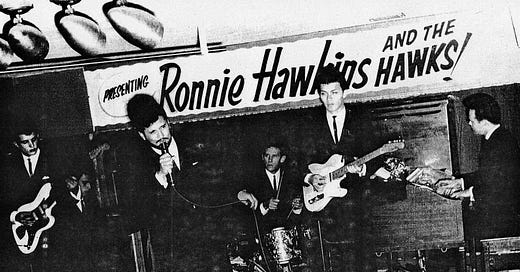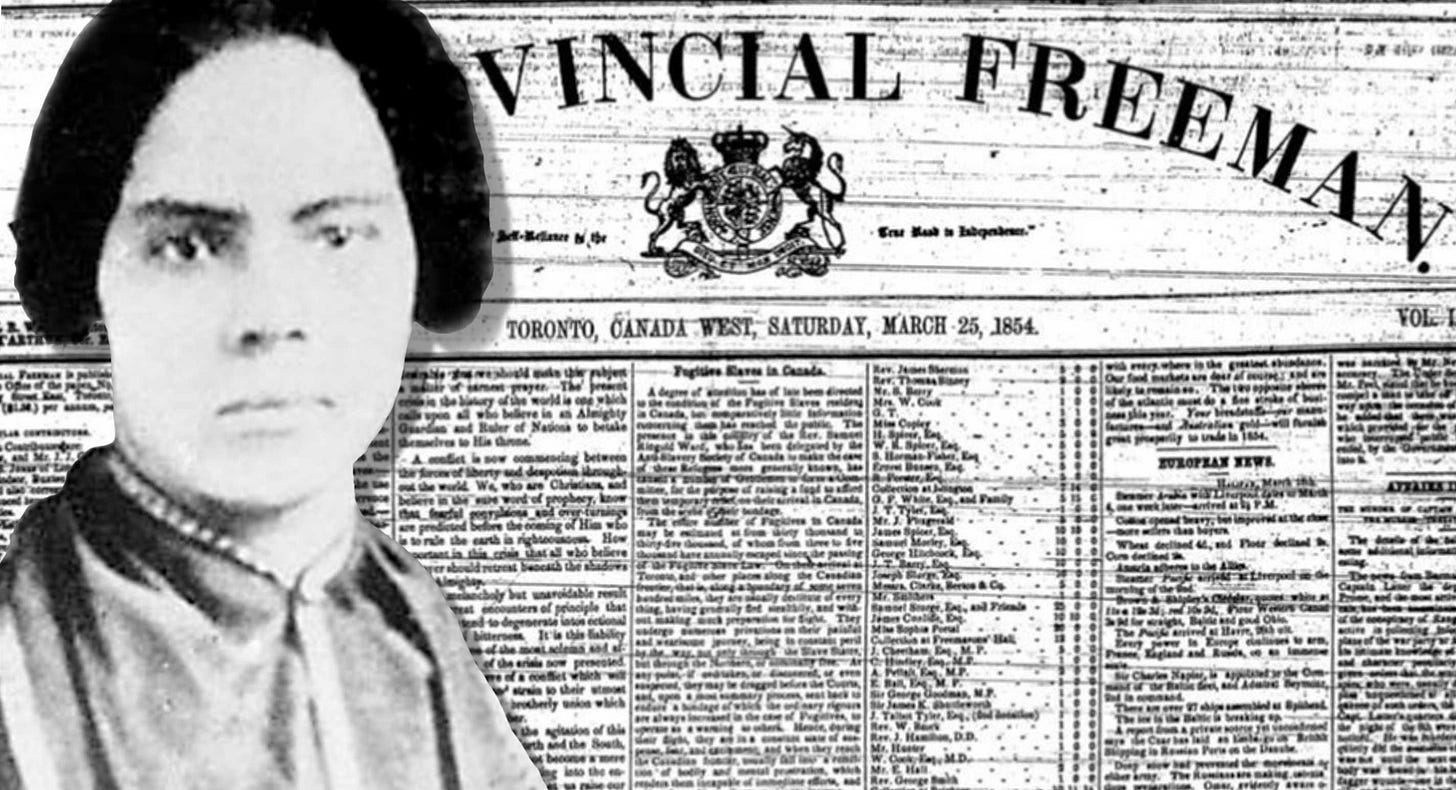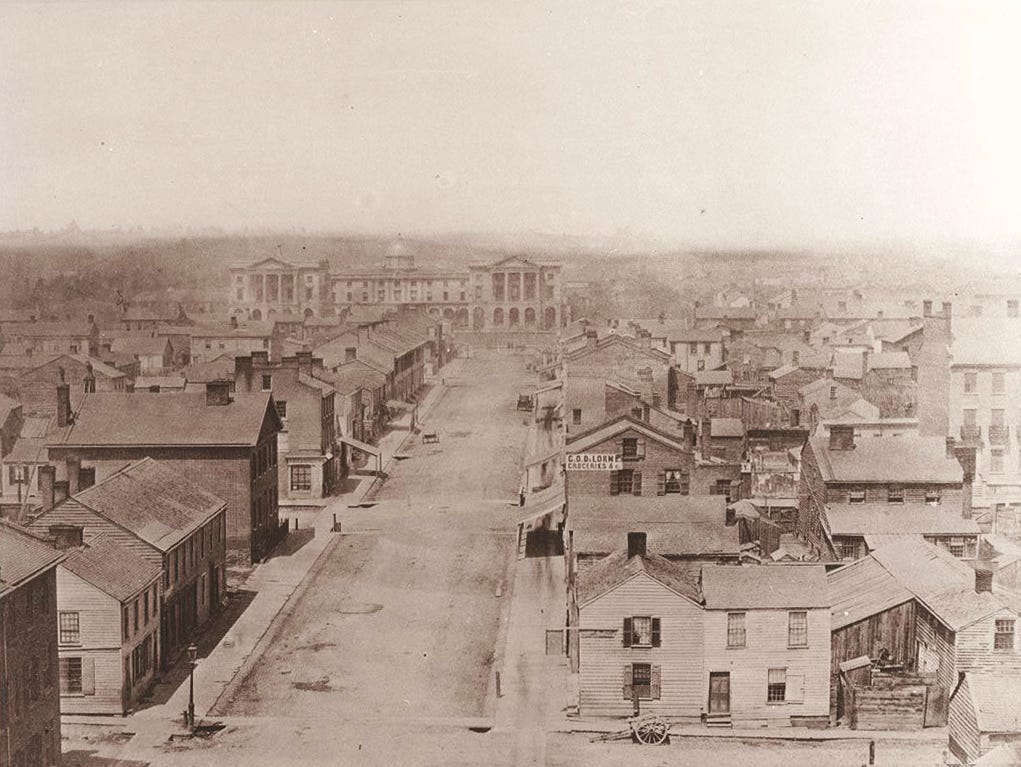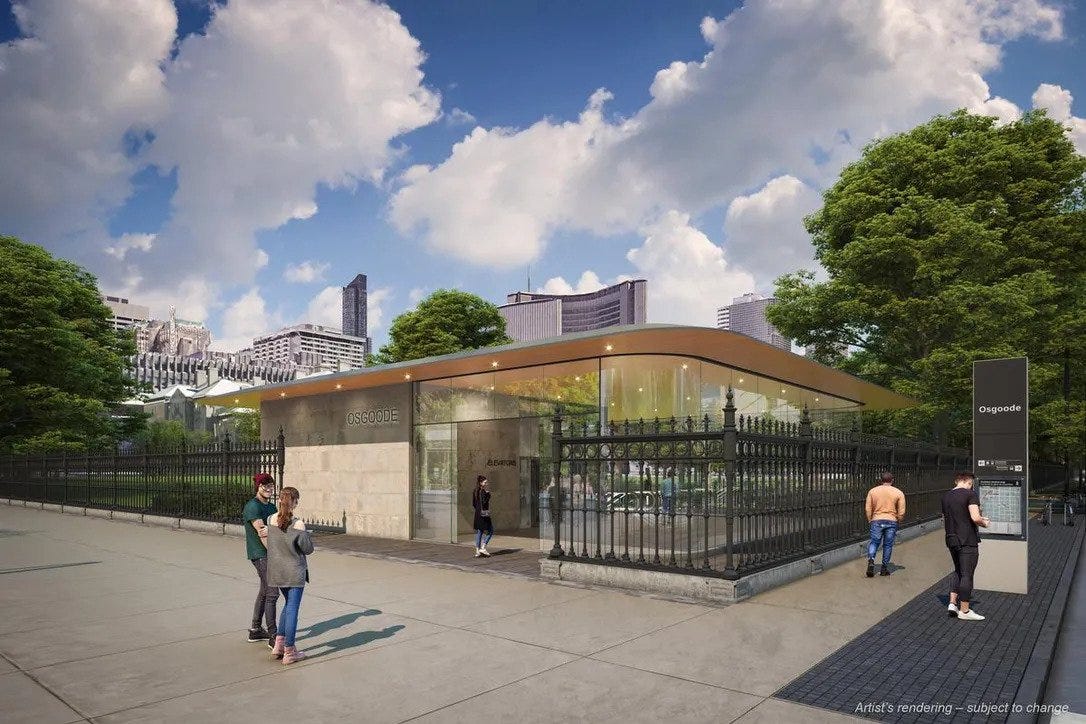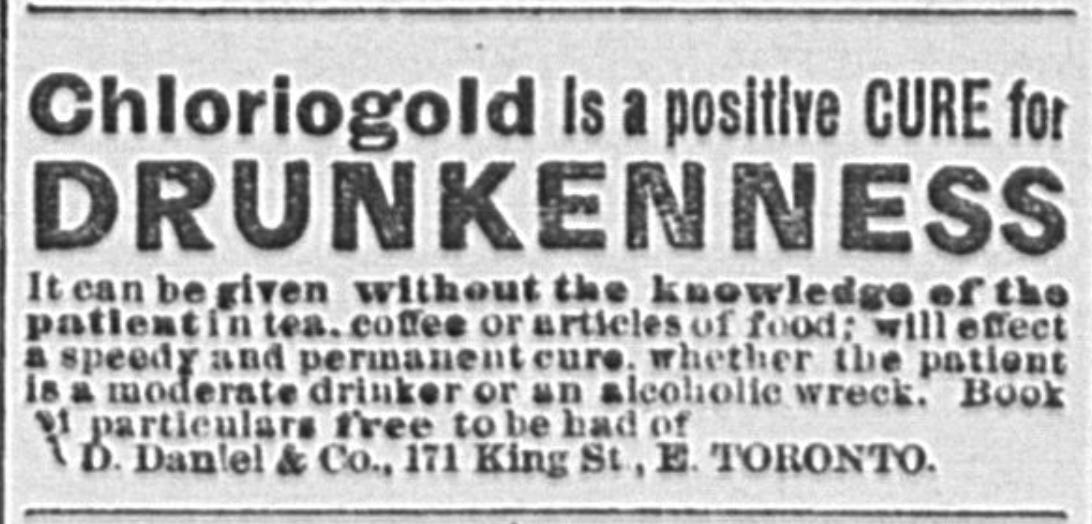Saying Goodbye To A Toronto Rock Pioneer
Plus the fight over the future of Osgoode Hall and more.
This week in 1893, Mary Ann Shadd died. Born in the United States to parents who operated a station on the Underground Railroad, she later came to Upper Canada and became one of our province’s leading abolitionists. In Toronto, she started publishing The Provincial Freeman, becoming the first Black woman on the continent to run her own newspaper. She used it to fight for an end to slavery in the U.S., equal rights on both sides of the border, and women’s suffrage, among other causes. She even played a tangential role in sparking the American Civil War (which we’ll be covering in a future episode of Canadiana).
This week in 2022, we’ll remember one of our city’s musical icons, talk about the subway station that threatens to carve away a piece of Osgoode’s Hall property, and more.
But first, a quick and friendly reminder that it takes a ton of work to write this newsletter every week, so the only way I’ll be able to keep doing it is if enough of you are willing to switch to a paid subscription. For a few dollars a month, you’ll be supporting all the work I do — and get some fun extras in return, too, like access to free online talks, discounts off my online courses, and more.
You can make the switch — or subscribe for free if you haven’t already — by clicking here:
Thanks to everyone who reads, subscribes and spreads the word!
SAYING GOODBYE TO A TORONTO ROCK LEGEND
ROMPIN’ NEWS — Ronnie Hawkins was born two days after Elvis, destined to take his own place among that first generation of jukebox rockers. The term “rock & roll” hadn’t even been coined when he started his first band; he was still a teenager growing up in Arkansas at the time. His music was on the cutting edge of the 1950s, a bluesy rockabilly deeply influenced by the Black musicians he played with, sweaty, raw and electric, with a back-flipping, moonwalking live show to match.
It was in 1958 that he headed north. And as he toured through Southern Ontario, Hawkins quickly realized Canadians had a hunger for rock & roll that wasn’t being fully fed. So he made the move permanent, setting up shop in the rough and tumble taverns of Yonge Street. He became a pioneer of what would become known as “The Sin Strip.”
Toronto was still a very conservative place. It was dominated by the old Victorian morality of “Toronto The Good,” a town where access to booze was strictly limited and movies, plays, and tobogganing were all banned on Sundays. But the Yonge Street Strip was beginning to shake some of that up: first with cocktail bars and jazz clubs, then with infamous rock venues like the Coq d’Or, where Ronnie Hawkins & The Hawks had become a fixture by the early 1960s — and where they helped transform our city in the process.
Today, it’s easy to forget how unruly rock music seemed in those days. “When I first started playing rock & roll,” Hawkins later remembered, “I don’t guess there was anything more lower-life in the music field than a rock & roll singer. Everybody frowned on it: all the musicians frowned on it; all parents frowned on it… and all the clubs definitely wouldn’t have any of that loud noise ringing, crazy bunch of cats coming in there with those big amplifiers, breaking chandeliers and stuff.”
In order to make a living at it, you had to be prepared to play the diviest of dive bars. “We’ve played in every little honky tonk from Canada to Mexico,” Hawkins later told the CBC, “and they were plenty rough some of them. We’ve seen people killed in bars, we’ve seen people crippled in bars … We’ve looked down the barrel of a gun several times … I’ve gotten more threats than the president of the United States.” That all prepared him for life on the Strip, where bar brawls were a nightly occurance. “I’m the toughest rock & roller on Yonge Street,” he boasted with a chuckle.
And his backing band was plenty tough, too.
The Hawks were originally all Americans who joined Hawkins on the journey north. But as those musicians began to return home, he replaced them with local Canadians. Eventually, only the drummer Levon Helm was left from the original group. He’d been joined by Robbie Robertson, Rick Danko, Garth Hudson and Richard Manuel. They were no strangers to bar brawls themselves. Hawkins designed custom suits for them to wear on stage, with special pockets where they could conceal brass knuckles, blackjacks and pistols in case they had to battle their way through the crowd at the end of their set. Two of them once jumped into a street fight in Yorkville to save a draft-dodging rhythm & blues singer who was getting roughed up by a group of American soldiers; the young man turned out to be future ’80s pop star Rick James. (I told the story in The Toronto Book of the Dead.) In the face of The Hawks’ toughened fists, the American soldiers retreated. Hawkins once declared, “They were probably the toughest band in the world.”
But he also called them “the most over-worked, underpaid band in the world.” A stern taskmaster, he pushed them to their limits, and then beyond. The Hawks eventually got tired of the treatment and left Hawkins behind, continuing to play the Strip until their big break came calling.
In 1965, Bob Dylan was planning to leave his acoustic folk roots behind and embrace electric rock. But to do it, he needed a backing band of his own. When his manager’s assistant, who happened to be from Toronto, suggested he check out The Hawks, he came to see them at Friar’s Tavern (which is now the Shoppers Drug Mart on Yonge & Dundas Square, which has a tiny music museum on the second floor). They passed the audition, renamed themselves The Band, and became one of the most popular rock groups on the planet.
As for Hawkins, he stayed in Canada for the rest of his life and continued to add to his legend. “He hired a chauffeur for his cars, lit his cigars with dollar bills,” as one reporter put it. “His name was synonymous with wild parties, booze and broads.” He claimed he once bought a Rolls-Royce with cash he carried in a bag from Honest Ed’s. He even hosted John Lennon and Yoko Ono at his big house outside the city, giving them rides on his snowmobile while they reportedly ran up a $16,000 phone bill and trashed his bathroom.
And though he passed away last Sunday at the age of 87, his legacy in Toronto will be felt for a long, long time to come — a place he helped transform from a notoriously boring town into one of the world’s great music cities. The rock & roller’s influence was so seminal that when Jonny Dovercourt wrote his history of music in Toronto, Any Night of the Week, he began it with the night Ronnie Hawkins arrived, pulling up in a Chevy outside the Coq d’Or for the very first time.
Toronto would never be the same again.
READ MORE & LISTEN TO THE CBC IDEAS EPISODE ABOUT RONNIE HAWKINS
THE FIGHT OVER THE FUTURE OF OSGOODE HALL
THE FENCE WASN’T REALLY BUILT TO KEEP COWS OUT NEWS — Osgoode Hall is one of the oldest buildings in Toronto. Construction began all the way back in the 1820s, when our city was just three decades old. It’s been standing there at the top of York Street for nearly 200 years, with further additions tacked on over the course of those two centuries. It’s played an important role in the city: home to the law society, courts, libraries, a law school… After the rebellion in the 1830s, it was even used as barracks for soldiers stationed here to keep an eye out for further unrest. (One of whom became caught up in one Toronto’s great sex scandals, which I wrote about in The Toronto Book of Love.)
Today, it’s a bit hidden — tucked away behind its black iron fence and the leafy trees that stand in the green space surrounding it. And now some of that fence, the green space, and those big old trees are in danger. Metrolinx plans to encroach on Osgoode Hall’s property, tearing down some of the famous iron fence, killing some of those leafy trees, and drilling down through the lawn to build a subway station beneath it — all part of the construction of the new Ontario Line.
But not if John Tory can help it.
According to Ben Spurr’s reporting in The Toronto Star, “the normally cool-headed mayor appeared fired up as he slammed the proposal, which he said Metrolinx hadn’t consulted him on. ‘I’m all for building transit but I can tell you right now, “Hands off Osgoode Hall premises.”’”
Metrolinx claims there’s no way around it. But some people, including The Globe and Mail’s architecture critic Alex Bozikovic, have pointed out that there does seem to be at least one other option. It looks like the station could take over a couple of lanes of University Avenue instead…


…which would compliment an existing proposal to redesign the road, shifting the traffic lanes to the west side of the street while creating a big downtown park:


But in the end, it might not matter what Toronto wants. As Ben Spurr points out, the province has the power to overrule the city. And this particular provincial government certainly seems to have had no problem doing that before.
QUICK LINKS
The best of everything else that’s new in Toronto’s past…
MISS CHIEF EAGLE TESTICKLE NEWS — The ROM has announced they’ll be hosting a new show by Cree artist Kent Monkman this fall, featuring his gender-fluid alter ego Miss Chief Eagle Testickle. It will explore “how Indigenous presence and knowledge is embedded in this land much longer and deeper than how it’s been presented in the colonial version of history here on Turtle Island.” And it will “use a ‘Cree lens’ to refer to and depict objects from the ROM’s collection, such as fossils, meteorites and moccasins.” It will open October 8. Read more.
HERITAGE TREE NEWS — Forests Ontario have added a new tree to their Heritage Tree list. “The Applebee Catalpa” has been growing in Long Branch — at the corner of Twenty Third Street and Iris Road — since the 1800s. It now towers 70 feet into the sky above Etobicoke. Read more.
DRUG YOUR LOVED ONES NEWS — Katherine Taylor has a new post up at her One Gal’s Toronto blog, heading to King Street East to find what may very well be the oldest ghost sign in our city while exploring the history of a pair of Toronto’s early drugists.
My favourite part of the post, though, may very well be this add for a sketchy cure for drunkenness, especially the bit that declares “It can be given without the knowledge of the patient”:
EVERY CITY IS A CITY OF MEMORIES NEWS — …while she also re-shared a wonderfully touching post she wrote in 2020, after he sister passed away. Its filled with memories of their childhoods and a powerful reminder of the way everyone has their own personal historical landmarks within the city. Read more.
NOT WEIRD AT ALL NEWS — …and she also shared this perfectly normal little piece of history on Twitter:


KING & SPADINA NEWS — A new office tower has been proposed for a spot where two heritage buildings currently stand, on the north-west corner of King & Spadina, where the old Global Backpackers used to be. One heritage building would be saved, the other reduced to a facade, a new Claude Cormier + Associés-designed pedestrian plaza would run through (that’s the guy behind the Berczy Park dog fountain among other things), and there be no parking for cars, just bikes. Read more.
STRANDED TRIANGLE NEWS — Bob Georgiou dives into a map from the 1960s to find a neat little story about a triangle of land left stranded by railway tracks in the 1890s:


BIZARRE BOAT NEWS — The Toronto Past Archive shares one of the weirdest stories from our city’s past: the tale of the bizarre cylindrical “rollerboat” invention that briefly grabbed local headlines at the end of the 1800s and very early 1900s. Read more.
STABLE NEWS — Misha Gajewski takes a look inside a very old laneway house in Riverdale. The home was originally built in the 1880s to serve as the stables for the fire hall next door. Read more.
TORONTO HISTORY EVENTS
1851: SPIRIT & VOICE
June 8 — 7pm — Online — Myseum
“Back by popular demand! Welcome to 1851: Spirit & Voice, a theatrical and playful revisiting of the 1851 North American Convention of Coloured Freemen. Through this new work written by playwright Luke Reece, step into the world of a fictionalized digital conference where the past and present collide.
“Live from St. Lawrence Hall, Marie and Anthony host a retrospective look at the gathering of 19th century abolitionists in Toronto, when their event is crashed by ghosts of conventions past. Together our characters grapple with the way history has been written, as well as issues that affect Black lives today. Watch leading historical figures Mary Ann Shadd Cary, Henry and Mary Bibb, and Frederick Douglass share their unfiltered thoughts on historical storytelling and 21st century anti-Black racism.”
Free with registration.
ERNEST D. BANTING’S LIFE IN WESTON
June 16 — 7:30pm — Online — Etobicoke Historical Society
“Ernest D. ‘Doc’ Banting (1892-1973), a distant cousin to Dr. Frederick Banting, discoverer of Insulin, was a leading citizen of the Town of Weston in the mid-1900’s. As a salesman and politician in a career that spanned more than five decades from the 1920s to the 1970s, ‘Doc’ was a shameless self-promoter but a constant home-town booster … and a bit of a rogue.
“Join EHS Historian Richard Jordan as he follows ‘Doc’ around the town while exploring topics like small town sports, municipal politics, the Orange Order, the effects of the Depression, the birth of Canada’s unemployment system, the role of service clubs like the Lions and, last but not least, temperance. Vividly recreating a community from a vanished era, Richard will draw on research from his newly-published book, Ernest D. Banting and Life in Weston 1921-1973.”
Free for members; an annual membership is $25.
TORONTO STREETCAR PHOTOS: INTERPRETING URBAN CHANGE THROUGH A CRITICAL VISUAL ANALYSIS
June 16 — 12pm — Online — University of Waterloo
“This talk is based around the book Streetcars and the Shifting Geographies of Toronto, which studies the city’s urban transformations through an analysis of photographs taken by streetcar enthusiasts, beginning in the 1960s. These photographers did not intend to record the urban form, function, or social geographies of Toronto; they were "accidental archivists" whose main goal was to photograph the streetcars themselves. But today, their images render visible the ordinary, day-to-day life in the city in a way that no others did. These historic photographs show a Toronto before gentrification, globalization, and deindustrialization. Each image has been re-photographed to provide fresh insights into a city that is in a constant state of flux.”
Free with registration!
SUMMER HISTORY SERIES: THE KINGSWAY
July 21 — 7:30pm — Online — Etobicoke Historical Society
“One of Canada’s premier neighbourhoods, The Kingsway was the vision of one man, Robert Home Smith. A lawyer by training but a natural-born town planner, Home Smith took 3,100 acres of ordinary Etobicoke farmland and turned it into an elegant series of subdivisions that were deemed ‘A bit of England far from England’. Centered around the Old Mill, they offered not only a new vision of town planning but of upper middle class life in Toronto. So ‘jump on the bus’ with EHS Historian Richard Jordan for an enjoyable virtual journey through this picturesque and historic neighbourhood.”
Free for members; an annual membership is $25.

